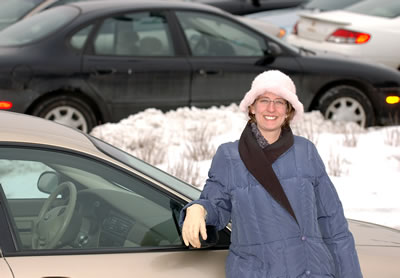|
By Craig Wilkins

Jennifer Conover visits a park and ride lot in a shopping center at Interstate 35W and 98th Street in Bloomington. Photo by David Gonzalez |
The use of park-and-ride lots in the Twin Cities metropolitan area showed a sharp increase during 2007.
Overall, use rate reached more than 10 percent higher than during the previous year, said Jennifer Conover, the Metro District’s Team Transit project manager.
Conover said the increase was fueled in part by new facilities, added capacity at existing lots and increased demand. Some of the higher demand, she said, stems from commuters who altered their travel after the collapse of the Interstate 35W bridge in Minneapolis.
Some facilities on commuter routes directly affected by the collapse recorded increases of nearly 15 per cent, Conover said.
The average annual increase in use is about four percent.
Increased use of the park-and-ride lots also reflects a sharp upswing in the use of public transit last year.
In 2007, overall bus ridership increased by 5.1 percent to 67.9 million rides, said Jill Hentges, a community outreach worker with Metro Transit.
Hentges serves with Conover on Team Transit.
In addition, she said the number of riders using the Hiawatha light rail transit line increased by 1.5 percent during 2007, bringing total ridership to 9.1 million.
Park-and-ride facilities range from shared parking lots at churches and shopping centers to multi-story garages that include bike lockers, passenger shelters and electronic messages about bus arrival and departure times.
Capacity was increased by about 11 percent last year, Conover said, with construction of several new lots and expansion of some existing facilities.
There are now 74 park and ride lots with a total capacity of 14,026 spaces.
Citing a study done by Metro Transit, Conover said trends indicate steady growth in demand for park-and-ride facilities.
“The study shows the transit system’s park and ride lots continue to attract a significant number of commuters from beyond Metro Transit’s taxing district and increasing numbers of long-distance commuters as well,” she said.
|



